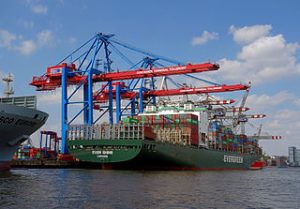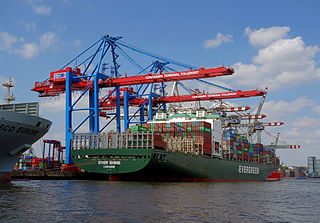 Evergreen has joined the league of big ships with its recent order for several ultra-large container vessels (ULCVs), driven by industry-prevalent fears that carriers with bigger ships will widen their competitive lead over the rest of the pack, said Drewry.
Evergreen has joined the league of big ships with its recent order for several ultra-large container vessels (ULCVs), driven by industry-prevalent fears that carriers with bigger ships will widen their competitive lead over the rest of the pack, said Drewry.
The maritime consultant and analyst said the announcement last week by Evergreen to time-charter 11 ULCVs of 20,000 TEUs—the nominal capacity stated by builders Imbari rather than Evergreen’s operational estimate of 18,000 TEUs—indicates carriers’ growing awareness of the implications of being left behind in the race to deploy the biggest ships.
But Drewry said that unlike before, the decision to move to bigger ships is now less an individual-carrier decision but more an influence of the requirements of the mega-alliance it belongs to. Thus, it predicts that forthcoming ULCV purchases or charters will be dictated by how these can be leveraged as alliances square off.
“The new mega-alliances will offer the have-nots access to the big ships through vessel sharing agreements. Drewry expects future ULCV orders to be placed according to alliance needs rather than meeting individual lines’ requirements,” it said.
Although they are yet to be confirmed, the highly anticipated orders by G6 Alliance carriers OOCL and MOL for two sets of six 18,009-20,000 TEU ships “would be a clear example of this way of thinking.”
Evergreen’s ships will join the CKYHE Alliance (Cosco, K Line, Yang Ming, Hanjin and Evergreen) services from 2018 through 2019.
The Taiwanese shipping line emphasized that the main draw of these ships is the cost savings, with the ship’s new generation G-type main engine developed with a longer stroke in order to sail at lower speeds. This, it added, will help to reduce fuel consumption and greenhouse gas emissions by an estimated 7 % compared with traditional main engines.
Maersk leading the way
The 18,000 TEU-plus club was formed by Maersk Line when it ordered the first tranche of 10 Triple E class ships in February 2011, which it followed in June of the same year with an order for 10 more.
Two years later, CSCL, MSC, and UASC ordered their own sets, and almost fully four years since the first Maersk order, Evergreen has become the fifth member of the club.
“Maersk Line has clearly enjoyed considerable first-mover benefits, demonstrated by its market leading profitability in recent years. Eventually, all other major carriers, to varying degrees, have picked up the baton and looked to replicate its success by introducing comparable vessels,” said Drewry.
However, while Maersk Line has always led and other carriers eventually followed, Drewry now observes a difference: “The main change is that carriers are taking less time to play catch-up.”
It noted that while Maersk had a five year start when it ordered its first 8,000-9,000-TEU ships in early 1995, it took OOCL five years to time-charter in November 2000 two 8,063-TEU ships that were delivered in mid-2003.
Maersk raised the bar to new heights in March 2004 with its order for eight 15,550-TEU Emma Maersk series. At just over two years, MSC ordered smaller but comparable versions of their own: eight 13,800 TEUs and five 13,800 TEUs ordered in June 2006.
Maersk made another quantum leap with an order for 20 of the 18,220-TEU Triple E ships, ordered in February and June 2011 and delivered from 2013 through 2015. This time, it took CSCL just over two years to react with a May 2013 order for five 19,100-TEU ships, the first of which, CSCL Globe, was delivered in January 2015 to briefly become the world’s largest container ship.
CMA CGM also moved for slightly smaller 17,000-TEU units in June 2013, while MSC (via time charter) and UASC ordered 18,000-19,000-TEU ships in July and August 2013. Both carriers added more last year, followed by the Evergreen order this year.
Dwindling opportunity
As the size of the biggest ships gets larger, the opportunity for carriers to follow suit gets smaller.
Said Drewry, “In the short-to-medium term the demand simply does not exist for all lines to have 12 x 18-20,000 TEU ships required for a weekly service of their own. What this means is that the container industry will effectively become a two-tier arena with the haves enjoying far greater economies of scale over the have-nots.”
Through mega-alliances, those that can’t afford big ships can get access through vessel sharing agreements. “This approach will spread the benefits across the alliance members—assuming the costs are equally shared—and at the same time will prevent the industry being flooded with far too much capacity,” stated Drewry.
The expected orders from MOL and OOCL will enable the G6 Alliance to join the big ship club, but they will merely limit the damage to the alliance’s market share in the East-West trades as other carrier groups have bigger plans in place. Despite this fact, at present it seems unlikely that more orders from other G6 members will materialize in the near term.
The 2M carriers, Maersk and MSC, have a distinct advantage in terms of 18,000-20,000-TEU ships already on the water with another 360,000 TEUs worth to be delivered.
The Ocean Three lines—CMA CGM, CSCL and UASC—are well catered for up to 2016 with the latter two carriers taking delivery of around 132,000 TEUs worth of 18,000-20,000-TEU ships. CMA CGM has a number of ships just outside this range at 17,700-TEU, all of which are due 2015.
The Evergreen order represents the only 18,000-20,000-TEU ships for the CKYHE Alliance, for which they will have to wait at least three years. The next biggest orders are 30 of 14,000-TEU units for Cosco, Evergreen and Yang Ming, which suggests they won’t have the room for more of the larger ships.
“There is not enough cargo for everyone to have ULCVs so future orders will be dictated by alliance needs and not those of individual lines. The window of opportunity for carriers to order 18,000-20,000-TEU ships is closing and those that do not make the leap will struggle to compete on slot costs,” concluded Drewry.
Photo: Rainer Lippert





